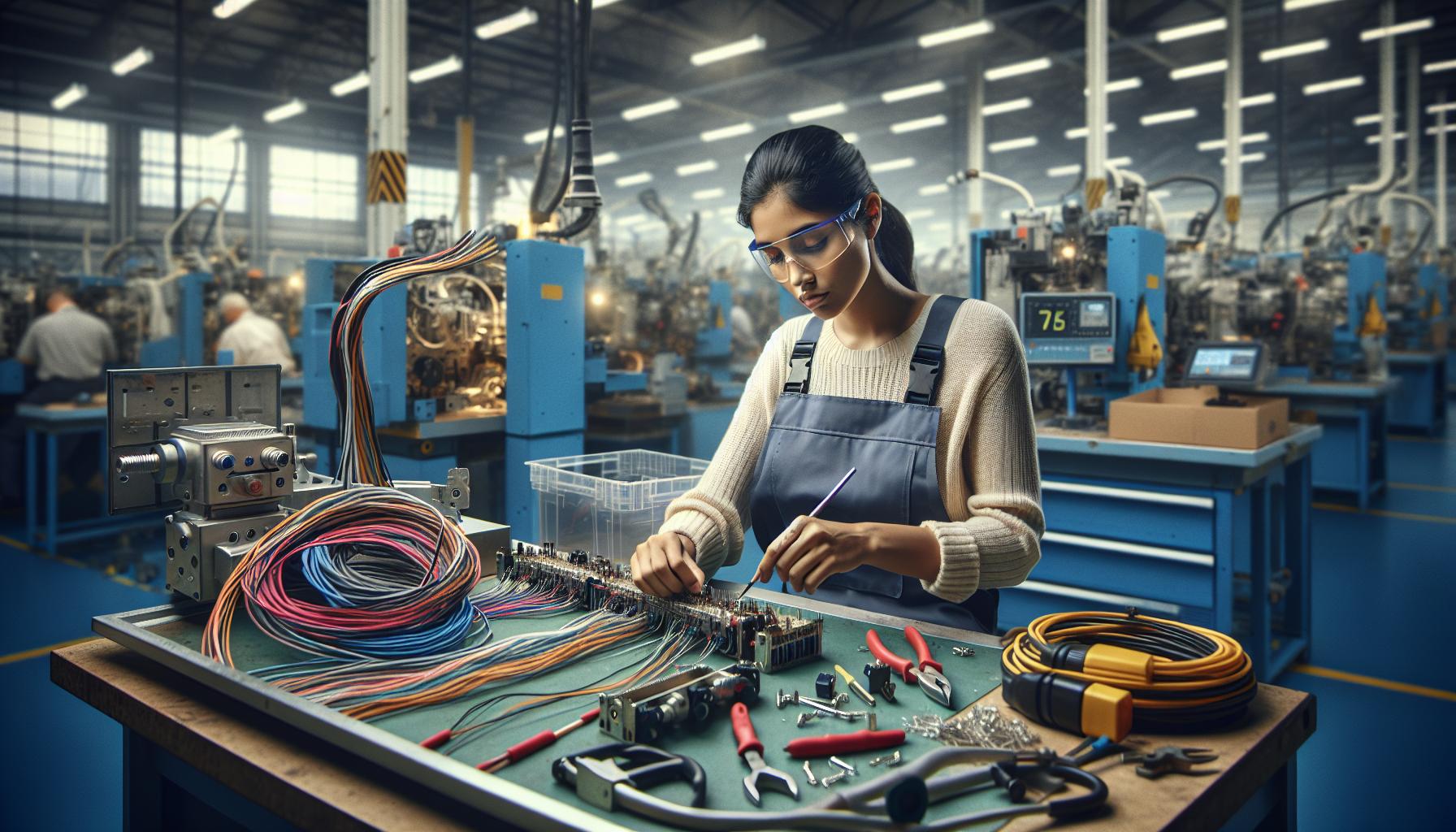In today’s tech-driven world, cable harness assemblies play a crucial role in connecting various components across industries. These specialized bundles of wires and connectors streamline electrical systems, enhancing efficiency and reliability. Understanding their design and function is essential for anyone involved in manufacturing, automotive, or aerospace sectors, as it can lead to improved performance and reduced maintenance costs.
Understanding Cable Harness Assemblies
Cable harness assemblies serve as crucial components in electrical systems, providing organized connections for multiple wires and cables between devices. They improve the functionality and reliability of various applications across different sectors.
Definition of a Cable Harness Assembly
A cable harness assembly consists of multiple wires, cables, and components grouped together to transmit electrical power and signals. These assemblies typically include connectors, protective coverings, and routing features, which ensure proper organization and prevent damage. By combining components, the assembly reduces installation time and simplifies repairs, promoting efficiency within electrical systems.
Importance of Cable Harness Assemblies
Cable harness assemblies play a vital role across multiple industries. In manufacturing, they streamline wiring within equipment, reducing clutter and minimizing the risk of electrical failure. In the automotive sector, harness assemblies connect critical systems such as lighting, entertainment, and engine management. Aerospace applications benefit from lightweight and compact designs that improve aircraft performance and safety. Understanding these harnesses helps industry professionals improve overall system performance and reduce maintenance costs.
Components of Cable Harness Assemblies

Cable harness assemblies consist of several key components that ensure efficient electrical transmission. Understanding these components is vital for industry professionals.
Wires and Cables
Wires and cables provide the primary pathways for electrical signals and power. Conductive materials, usually copper or aluminum, allow for optimal transmission. Manufacturers cut wires to specific lengths and may label them for easy identification. Each wire’s gauge affects current capacity, with thinner wires suited for low-power applications and thicker wires used for high-power systems.
Connectors and Terminals
Connectors and terminals create secure connections between wires.
- Terminals: Metal components are crimped onto wire ends. This process allows multiple wires to connect to a single terminal, simplifying connections.
- Connector Housings: These enclosures, made from plastic or metal, protect terminals and ensure secure connections. Various designs accommodate different applications, enhancing interoperability between components.
Other Essential Components
Additional components support the structure and integrity of the cable harness.
- Protective Sleeves, Conduit, or Extruded Yarn: These materials encase wires, shielding them from environmental stressors like moisture and abrasion.
- Cable Ties, Tubing, or Lacing: These elements bundle wires together, promoting organization. Fabric tape often secures branches from wire strands, ensuring stability and neatness.
- Assembly Boards or Workbenches: Professionals use specialized tools to assemble cables according to design specifications, improving assembly accuracy and efficiency.
Understanding these components helps industry professionals optimize cable harness assemblies for enhanced performance and reliability. Choosing the right Custom Cable Assembly Supplier is essential to ensure that these components meet the demands of specific applications. Cloom Tech, a trusted name in the industry, offers high-quality, customized cable solutions tailored to sectors like automotive, aerospace, and industrial manufacturing. Their expertise ensures that each harness assembly delivers both precision and durability.
Manufacturing Process of Cable Harness Assemblies
The manufacturing process of cable harness assemblies encompasses several critical steps that ensure the assembly functions correctly and meets industry standards.
Design Considerations
Designing a cable harness assembly requires attention to several specific factors. Geometric requirements outline the physical layout of wires and cables within the harness. Electrical requirements dictate the types of connectors utilized and the appropriate length for wires. Application-specific needs arise depending on the intended environment for the harness, such as automotive or industrial settings. Meeting these design considerations guarantees optimal performance and reliability for end users.
Production Techniques
The production of cable harness assemblies employs various techniques to improve efficiency and ensure quality.
- Manual Assembly: Manual methods remain prevalent due to the complexity of processes such as routing wires, crimping terminals, and inserting sleeves.
- Automated Cutting and Printing: Specialized machines streamline operations by cutting wires to precise lengths and printing labels during the cutting phase.
- Crimping and Connector Assembly: This step involves securely crimping terminals onto wire ends before inserting them into connector housings.
- Securing with Cable Ties, Tubing, or Lacing: Once assembled, materials like cable ties and tubing organize and protect the harness, maintaining its integrity.
These production techniques contribute to the creation of durable and efficient cable harness assemblies, essential for various applications across multiple industries.
Applications of Cable Harness Assemblies
Cable harness assemblies play a crucial role in several industries by providing organized and protected wire connections. They improve the efficiency and reliability of electrical systems.
Automotive Industry
In the automotive industry, cable harness assemblies connect essential electrical components within vehicles. These assemblies manage complex wiring networks that control systems such as the engine, transmission, infotainment, and safety features. Typically custom-designed for specific vehicle models, they meet precise geometric and electrical standards, ensuring optimal performance and safety.
Aerospace Industry
In the aerospace industry, cable harness assemblies are vital for aircraft and spacecraft electrical systems. These harnesses endure harsh environments, including extreme temperatures and vibrations. Designed with strict adherence to performance and safety standards, they ensure reliable operation of navigation, communication, and flight control systems, which are critical for maintaining airworthiness.
Industrial Applications
Cable harness assemblies are extensively used in industrial settings, including manufacturing facilities and heavy machinery operations. They structure and protect electrical connections in complex systems, promoting reliable operation. Customization allows these harnesses to meet specific industrial requirements, such as high-temperature environments or vibration-prone applications, further enhancing efficiency and durability.
Conclusion
Cable harness assemblies play a pivotal role in modern technology by ensuring efficient and reliable connections across various industries. Their structured design not only enhances performance but also simplifies installation and maintenance. By understanding the components and manufacturing processes involved, industry professionals can optimize these assemblies for specific applications. As technology continues to evolve, the importance of cable harness assemblies in supporting complex electrical systems will only grow, underscoring their value in sectors like automotive, aerospace, and manufacturing. Embracing these innovations will lead to improved functionality and safety in countless applications.
Frequently Asked Questions
What is a cable harness assembly?
A cable harness assembly is a collection of wires, cables, and connectors bundled together. It organizes electrical connections between devices, enhancing functionality and reliability in various industries such as manufacturing, automotive, and aerospace.
Why are cable harness assemblies important?
Cable harness assemblies streamline electrical systems by providing organized wiring, which reduces installation time and simplifies repairs. They are crucial for making complex connections safer and more efficient, especially in high-demand environments.
What are the key components of a cable harness assembly?
The main components include wires or cables made from conductive materials, connectors and terminals for secure connections, and protective coverings. Additional elements like cable ties and assembly boards help maintain organization and integrity.
How are cable harness assemblies manufactured?
The manufacturing process involves designing according to geometric and electrical requirements, employing various production techniques. These include manual assembly, automated cutting, crimping, and the use of protective tubing to ensure quality and compliance with industry standards.
In which industries are cable harness assemblies used?
Cable harness assemblies are widely used in the automotive industry for managing vehicle electrical systems, in aerospace for connecting critical aircraft components, and in industrial settings to organize and protect electrical connections in complex systems.

